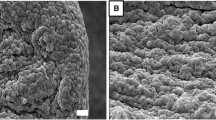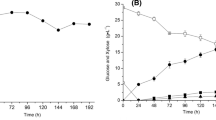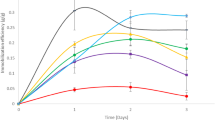Abstract
The exploitation of organo-silica immobilized lactic acid bacteria (LAB) to perform malolactic fermentation (MLF) in wine is described. The immobilization of a large amount of Oenococcus oeni cell culture was achieved by a two-step process in an original pilot plant. Cells are entrapped in Ca-alginate microbeads, coated with an organo-silica membrane obtained by two treatments: the first a sol suspension of tetraetoxysilane, the second using methyltriethoxysilane in gas phase. The resulting material improves the physico-chemical features of alginate, avoids cell leakage during fermentation, and protects the cells from antimicrobial compounds. In MLFs carried out at the microvinification scale, the activity of immobilized cells did not differ from that of free cells, and no differences were found in the chemical composition of the wines obtained. The use of immobilized bacteria allowed: (1) simultaneous alcoholic and malolactic fermentations in must inoculated with free yeast and immobilized bacteria; (2) the sequential MLF of three wine lots with the same biomass of immobilized bacteria; (3) the achievement of MLF in a wine with lysozyme added to suppress wild LAB and their potential spoilage.






Similar content being viewed by others
References
Avnir D, Coradin T, Lev O, Livage J (2006) Recent bio-applications of sol-gel materials. J Mater Chem 16(11):1013–1030
Bartowsky EJ (2003) Lysozyme and winemaking. Aust NZ Grapegrower Winemaker 473:101–104
Bartowsky EJ (2009) Bacterial spoilage of wine and approaches to minimize it. Lett Appl Microbiol 48(2):149–156
Bauza T, Blaise A, Teissedre PL, Mestres JP, Daumas F, Cabanis JC (1995) Changes in biogenic amines content in musts and wines during the winemaking process. Sci Aliment 15:559–570
Callone E, Campostrini R, Carturan G, Cavazza A, Guzzon R (2008) Immobilization of yeast and bacteria cells in alginate microbeads coated with silica membranes: procedures, physico-chemical features and bioactivity. J Mater Chem 18:4839–4848
Carturan G, Dal Toso R, Boninsegna S, Dal Monte R (2001) Encapsulation of supported animals cells using gas-phase inorganic alkoxides US Patent no. US 6214593
Carturan G, Dal Toso R, Boninsegna S, Dal Monte R (2004) Encapsulation of functional cells by sol-gel silica: actual progress and perspectives for cell therapy. J Mater Chem 14(14):2087–2098
Carturan G, Campostrini R, Tognana L, Boninsegna S, Dal Toso R, Dal Monte R (2006) Gas-phase silicon alkoxide reactivity vs. Na-alginate droplets for conjugation of alginate and sol-gel technologies. J Sol-gel Sci Technol 37(1):69–77
Diviès C, Cachon R (2005) Wine production by immobilised cell systems. In: Nedovic V, Willaert R (eds) Applications of cell immobilisation biotechnology. Springer, Amsterdam, pp 285–293
Garbay S, Lonvaud-Funel A (1996) Response of Leuconostoc oenos to environmental changes. J Appl Bacteriol 81:619–625
Gerbaux V, Villa A, Monamy C, Bertrand A (1997) Use of lysozyme to inhibit malolactic fermentation and to stabilize wine after malolactic fermentation. Am J Enol Viticult 48:49–54
Groboillot A, Boadi DK, Poncelet D, Neufeld RJ (1994) Immobilization of cells for application in the food industry. Crit Rev Biotechnol 14(2):75–107
Guzzon R, Poznanski E, Conterno L, Vagnoli P, Krieger-Weber S, Cavazza A (2009) Selection of a new high resistant strain for malolactic fermentation in difficult conditions. S Afr J Enol Vitic 30(2):133–141
Idris A, Suzana W (2006) Effect of sodium alginate concentration, bead diameter, initial pH and temperature on lactic acid production from pineapple waste using immobilized Lactobacillus delbrueckii. Process Biochem 41(5):1117–1123
Kourkoutas Y, Bekatorou A, Banat IM, Marchant R, Koutinas AA (2002) Immobilization technologies and support materials suitable in alcohol beverages production: a review. Food Microbiol 21(4):377–397
Liu SQ (2001) Malolactic fermentation in wine. Beyond deacidification. J Appl Microbiol 92(4):589–601
Lonvaud-Funel A (1999) Lactic acid bacteria in the quality improvement and appreciation of wine. Antonie van Leeuwenhoek 76:317–331
Lonvaud-Funel A (2001) Biogenic amines in wines: role of lactic acid bacteria. FEMS Microbiol Lett 1:9–13
Maicas S (2001) The use of alternative technologies to develop malolactic fermentation in wine. Appl Microbiol Biotechnol 56(1–2):35–39
Malherbe S, Bauer FF, Du Toit M (2007) Understanding problem fermentations. A review. S Afr J Enol Vitic 28(2):169–186
OIV (2009) Analyse microbiologique des vins et de moûts. In: Recueil des méthodes internationales d’analyse des vins et des moûts. Organisation Internationale de la Vigne et du Vin, Paris
Zapparoli G, Tosi E, Azzolini M, Vagnoli P, Krieger S (2009) Bacterial Inoculation Strategies for the Achievement of Malolactic Fermentation in High-alcohol Wines. S Afr J Enol Vitic 30(1):49–55
Author information
Authors and Affiliations
Corresponding author
Rights and permissions
About this article
Cite this article
Guzzon, R., Carturan, G., Krieger-Weber, S. et al. Use of organo-silica immobilized bacteria produced in a pilot scale plant to induce malolactic fermentation in wines that contain lysozyme. Ann Microbiol 62, 381–390 (2012). https://doi.org/10.1007/s13213-011-0272-z
Received:
Accepted:
Published:
Issue Date:
DOI: https://doi.org/10.1007/s13213-011-0272-z




